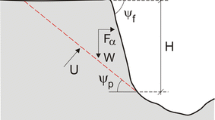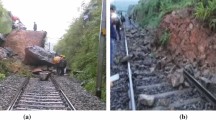Abstract
The slope instability is connected to a large diversity of causative and triggering factors, ranging from inherent geological structure to the environmental conditions. Thus, assessment and prediction of slope failure hazard is a difficult and complex multi-parametric problem. In contrast to the analytic approaches, the systems approaches are able to consider infinite number of affecting parameters and assess the interactions of each couple of the parameters in the system. This paper presents a complete application of the rock engineering systems approach in prediction of the instability potential of rock slopes in 15 stations along a 20 km section of the Khosh-Yeylagh Main Road, Iran as the case study of the research. In this research, the main objective has been defining the principal causative and triggering factors responsible for the manifestation of slope instability phenomena, quantify their interactions, obtain their weighted coefficients, and calculate the slope instability index, which refers to the inherent potential instability of each slope of the examined region. The final results have been mapped to highlight the rock slopes susceptible to instability. Finally, as a preliminary validation on the utilization of systems approach in the study region, the stability of investigated rock slopes were analyzed using an empirical method and the results were compared. The comparisons showed a rather good coincidence between the given classes of two methods.









Similar content being viewed by others
Notes
Rock mass rating.
Slope mass rating.
Slope stability probability classification.
References
Ali KM, Hasan K (2002) Rock mass characterization to indicate slope instability in Bandarban: a rock engineering systems approach. Environ Eng Geosci 8(2):105–119
Bieniawski ZT (1976) Rock mass classification in rock engineering. In: Proceedings of the symposium on exploration for rock engineering, vol 1. Balkema, Rotterdam, pp 97–106
Bieniawski ZT (1993) Classification of rock masses for engineering—the RMR system and future trends. In: Hudson J (ed) Comprehensive rock engineering, vol 3. Pergamon Press, London, pp 553–574
Budetta P, Santo A, Vivenzio F (2008) Landslide hazard mapping along the coastline of the Cilento region (Italy) by means of a GIS-based parameter rating approach. Geomorphology 94:340–352
Castaldini D, Genevois R, Panizza M, Puccinelli A, Berti M, Simoni A (1998) An integrated approach for analyzing earthquake-induced surface effects: a case study from the Northern Apennins, Italy. J Geodyn 26(2–4):413–441
Ceryan N, Ceryan S (2008) An application of the interaction matrices method for slope failure susceptibility zoning: Dogankent settlement area (Giresun, NE Turkey). Bull Eng Geol Environ 67(3):375–385
Chacon J, Corominas J (2003) Landslides and GIS. Nat Hazards 30(3):263–512 (special issue)
Chacon J, El Hamdouni R, Irigaray C, Fernandez T (2006) Engineering geology maps: landslides and GIS. Bull Eng Geol Environ 65:341–411
Cundall PA (1976) Explicit finite difference methods in geomechanics. In: Proceedings of the 2nd international conference on numerical methods in geomechanics, vol 1. Blacksburg, Virginia, pp 132–150
Fernandez T, Irigaray C, El Hamdouni R, Chacon J (2008) Correlation between natural slope angle and rock mass strength rating, Granada, Spain. Bull Eng Geol Environ 67:153–164
Hack R (2002) An evaluation of slope stability classification. In: Proceedings of the EUROCK 2002, Madeira, Portugal, pp 3–32
Hack R, Price D, Rengers N (2003) A new approach to rock slope stability—a probability classification (SSPC). Bull Eng Geol Environ 62:167–184
Hoek E, Bray JW (1981) Rock slope engineering. Institution of Mining and Metallurgy, London
Hudson JA (1992a) Rock engineering systems, theory and practice. Ellis Horwood Ltd, Chichester
Hudson JA (1992b) Atlas of rock engineering mechanisms: part 2—slopes. Int J Rock Mech Min Sci 29(2):157–159
Hudson JA, Harrison JP (1992) A new approach to studying complete rock engineering problems. Q J Eng Geol 25:93–105
IGMEO, Iranian Geology and Mining Exploration Organization (2001) Geological map of Khosh-Yeylagh region in scale of 1:100,000. IGMEO, Tehran, Iran
IGOSIT, Iranian General Office for Statistics and Information Technology (2007) Annuals of meteorology. IGOSIT, Tehran, Iran
Irigaray C, Fernandez T, El Hamdouni R, Chacon J (1999) Verification of landslide susceptibility mapping: a case study. Earth Surf Process 24:537–544
Irigaray C, Fernandez T, Chacon J (2003) Preliminary rock-slope-susceptibility assessment using GIS and the SMR classification. Nat Hazards 30:309–324
Irigaray C, El Hamdouni R, Fernandez T, Chacon J (2007) Evaluation and validation of landslide susceptibility maps obtained by a GIS matrix method: examples from the Betic Cordillera (southern Spain). Nat Hazards 41:61–79
ISRM (1981) International Society for Rock Mechanics (ISRM) Suggested Methods. In: Brown ET (ed) Rock characterization, testing & monitoring-suggested methods, part 1: site characterization. Pergamon, Oxford
Kim KS, Park HJ, Lee S, Woo I (2004) Geographic Information System (GIS) based stability analysis of rock cut slopes. Geosci J 8(4):391–400
Kliche C (1999) Rock slope stability. Society for Mining, Metallurgy, and Exploration, Inc (SME), The United States
Koukis G, Rozos D, Hatzinakos I (1997) Relationship between rainfall and landslides in the formations of Achaia County, Greece. In: Proceedings of international symposium of iaeg in engineering geology and the environment, vol 1. AA Balkema, Rotterdam, pp 793–798
Larsson R, Runesson K, Axelsson K (1992) Finite element analysis of slope stability accounting for plastic localization. In: Proceedings of the 7th international conference on computer methods and advances in geomechanics, vol 3. A.A. Balkema, Rotterdam, pp 1711–1717
Latham J-P, Lu P (1999) Development of an assessment system for the blastability of rock masses. Int J Rock Mech Min Sci 36:41–55
Mazzoccola DF, Hudson JA (1996) A comprehensive method of rock mass characterization for indicating natural slope instability. Q J Eng Geol 29:37–56
Nash D (1987) A comparative review of limit equilibrium methods of stability analysis. In: Slope stability. Geotechnical engineering and geomorphology. John Wiley & Sons, Chichester
Norrish NI, Wyllie DC (1996) Rock slope stability analysis. In: Turner AK, Schuster RL (eds) Landslides Investigation and Mitigation, Transportation Research Board Special Report 247. National Academy Press, Washington, DC, pp 391–425
Notarpietro A (1990) Geological structure and landslides in the province of Sondrio. In: Cancelli A (ed) Alps 90, Alpine landslide practical seminar, sixth international conference and field workshop on landslides, Switzerland-Austria-Italy, Milano, Italy
Romana M (1985) New adjustment ratings for application of Bieniawski classification to slopes. In: Proceedings of the International Symposium on the Role of Rock Mechanics, ISRM, Zacatecas, pp 49–53
Romana M, Seron JB, Montalar E (2003) SMR Geomechanics classification: application, experience and validation. In: Proceedings of the ISRM 2003—technology roadmap for rock mechanics, South African Institute of Mining and Metallurgy, pp 981–984
Ross-Brown DM (1972) Design considerations for excavated mine slopes in hard rock. Research Report No 21, Departments of Civil Engineering, Geology and Mining and Mineral Technology, Imperial College of Science and Technology, London
Rozos D, Pyrgiotis L, Skias S, Tsagaratos P (2008) An implementation of rock engineering system for ranking the instability potential of natural slopes in Greek territory: an application in Karditsa County. Landslides 5(3):261–270
Smith GJ (1994) The engineering geological assessment of shallow mine workings with particular reference to chalk. Dissertation, University of London
Stead D, Benko B, Eberhardt E, Coggan J (2000) Failure mechanisms of complex landslides: a numerical modeling prospective. In: Bromhead et al (eds) Landslides in research, theory and practice: Proceedings of the 8th international symposium on landslides. Thomas Telford, Cardiff, London, pp 1401–1406
Stead D, Eberhardt E, Coggan J, Benko B (2001) Advanced numerical techniques in rock slope stability analysis—applications and limitations. In: Kuhne et al (eds) UEF international conference on landslides—causes, impacts and countermeasures. Verlag Gluckauf GmbH, Davos, Essen, pp 615–624
Varnes DJ (1978) Slope movement types and processes. In: Schuster RL, Krizek RJ (eds) Landslides Analysis and Control. Transportation Research Board Special Report 176. National Academy of Sciences, Washington
Wyllie DC, Mah CW (2004) Rock slope engineering, civil and mining, 4th edn. Spon Press, Taylor & Francis Group, Great Britain
Zare Naghadehi M, KhaloKakaie R, Torabi SR (2010) The influence of moisture on sandstone properties in Iran. PI Civ Eng Geotech Eng 163(2):91–99
Zhang LQ, Yang ZF, Liao QL, Chen J (2004) An application of the rock engineering systems (RES) methodology in rockfall hazard assessment on the Chengdu-Lhasa highway, China. Int J Rock Mech Min Sci 41(3):833–838
Acknowledgments
This work was financially supported by the research grant from Shahrood University of Technology. The authors wish to thank for helps and supports provided by the university during the research. Also, the comments received from and the enlightening discussions with our anonymous reviewers improved the paper and are appreciated.
Author information
Authors and Affiliations
Corresponding author
Rights and permissions
About this article
Cite this article
KhaloKakaie, R., Zare Naghadehi, M. The assessment of rock slope instability along the Khosh-Yeylagh Main Road (Iran) using a systems approach. Environ Earth Sci 67, 665–682 (2012). https://doi.org/10.1007/s12665-011-1510-1
Received:
Accepted:
Published:
Issue Date:
DOI: https://doi.org/10.1007/s12665-011-1510-1




